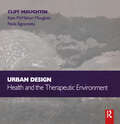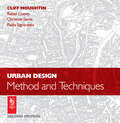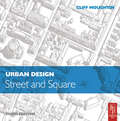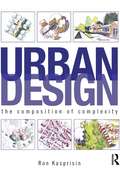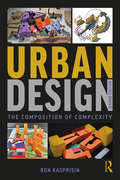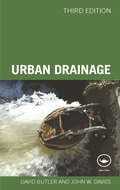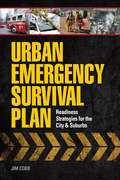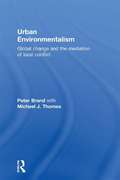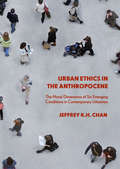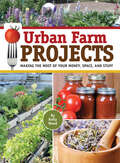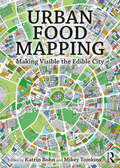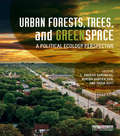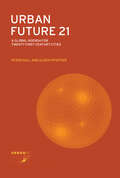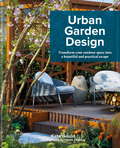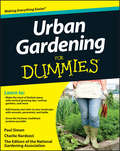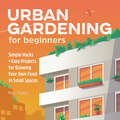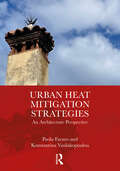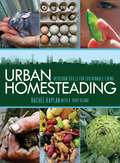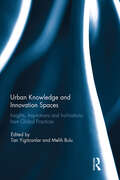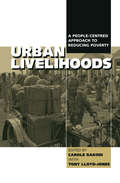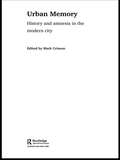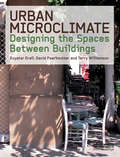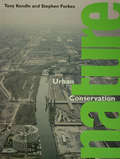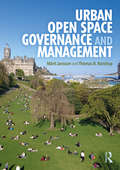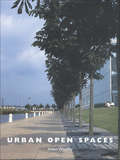- Table View
- List View
Urban Design: Health and the Therapeutic Environment
by Paola Signoretta Kate McMahon Moughtin J.C. Moughtin'Urban Design: Health and the Therapeutic Environment' demonstrates how urban design and planning impact on public health and sustainable development. Moughtin et al. explore the concept of what makes a physically and psychologically ‘healthy’ environment in the context of the paramount need for new homes where living standards are not compromised, in increasingly crowded cities. • Sets out the history and development of the healthy city, from the English spa town to standards of care in Cuba to provide a context for modern urban health development. • Covers a wide range of environmental, ecological, health and epidemiological issues. • Case studies and examples show how health policy and procedure is practically applied to sustainable urban development. 'Urban Design: Health and the Therapeutic Environment' outlines best practice for healthy, sustainable urban design and provides a reference tool for architects, urban designers, landscape architects, health professionals and planners. Emeritus Professor Cliff Moughtin was Professor of Planning in The Queen’s University Belfast and The University of Nottingham. He is author of a number of books including the series of five Urban Design titles for Architectural Press. Kate McMahon Moughtin is a psychotherapist. She is author of Focused Therapy for Organisations and Individuals. She is interested in how literature and environmental infl uences contribute to wellbeing. Paola Signoretta is a human geographer. She is a senior research associate in the Centre for Research in Social Policy, Loughborough University. She is interested in the geographies of health, deprivation and social and financial exclusion.
Urban Design: Method And Techniques
by Paola Signoretta Rafael Cuesta Christine Sarris J.C MoughtinThis book deals with a wide range of techniques used in the urban design process. It then goes on to relate these techniques to a unique, comprehensive account of method. A method of urban design is developed which has sustainability and environmental protection at the centre of its philosophy. Previously, literature regarding the urban design method has been almost totally neglected; this book introduces the topic to the reader. This revised Second Edition encompasses the latest techniques including the development of geographic information systems and financial techniques which help evaluate projects.A number of techniques are illustrated by example or case study. Where techniques are discussed they are located within the structure of the design process. The book develops a logical framework for a process, which includes problem definition, survey, analysis, concept generation, evaluation and implementation. It is this framework which leads toward the development of an urban design method. This book is a practical guide for students or professionals in the early part of their careers. It is organized so that each chapter provides guidance which readers would have otherwise had to discover for themselves, often with some difficulty.
Urban Design: Street And Square (Urban Design Ser.)
by Cliff MoughtinThis book, part of a series of four, offers a detailed analysis of urban design, covering the streets, squares and buildings that make up the public face of towns and cities. It outlines the theory of the principal features of urban design from which method is developed and provides a better understanding of the main elements of urban design. This includes the arrangement, design and details of the streets and squares, and the roles they play in city planning.This third edition includes chapters on "Sustainable Urban Design" and "Visual Analysis", introducing the latest theories and influences in the field and bringing greater practical significance to the book. Cliff Moughtin explores the street and square in terms of function, structure and symbolism and examines fine examples in their historical context. These are set against the background of the laws of urban design composition, culled from Renaissance and modern writers.
Urban Design: The Composition of Complexity
by Ron KasprisinFor planning to be successful, design must mean more than simply blindly following the dictates of legislation and regulation – yet losing sight of the importance of the design process is all too often exactly what has happened. Ron Kasprisin has written a book for students of planning and urban design that reconnects the process of designing with outcomes on the ground, and puts thinking about design back at the heart of what planners do. The book identifies the elements and principles of composition and explores compositional order and structure as they relate to the meaning and functionality of cities. It discusses new directions and methods, outlines the importance of both buildings and the open spaces between them. Mixing accessible theory, practical examples and carefully designed exercises in composition from simple to complex settings, Urban Design is an essential textbook for classrooms and design studios across the full spectrum of planning and urban studies fields. Not only filled with illustrations and graphics of excellent projects, it gives students tools to enable them to sketch, draw, design and above all, to think.
Urban Design: The Composition of Complexity
by Ron KasprisinUrban design is a process of establishing a structural order within human settlements; responding to dynamic emergent meanings and functions in a constant state of flux. The planning/design process is complex due to the myriad of on-going (urban) organizational and structural relationships and contexts. This book reconnects the process with outcomes on the ground, and puts thinking about design back at the heart of what planners do. Mixing accessible theory, practical examples, and carefully designed exercises in composition from simple to complex settings, Urban Design is an essential textbook for classrooms and design studios across the full spectrum of planning and urban studies fields. Filled with color illustrations and graphics of excellent projects, it gives students tools to enable them to sketch, draw, design, and above all, to think. This new edition remains focused on instructing the student, professional and layperson in the elements and principles of design composition so that they can diverge from conventional and packaged solutions in pursuit of a meaningful and creative urbanism. This edition builds upon established design principles and encourages the student in creative ways to depart from them as appropriate in dealing with the complexity of culture, space and time dynamics of cities. The book identifies the elements and principles of compositions and explores compositional order and structure as they relate to the meaning and functionality of cities. It discusses new directions and methods, and outlines the importance of both buildings and the open spaces between them.
Urban Drainage, Third Edition
by John Davies David ButlerUrban Drainage has been thoroughly revised and updated to reflect changes in the practice and priorities of urban drainage. New and expanded coverage includes: Sewer flooding The impact of climate change Flooding models The move towards sustainability Providing a descriptive overview of the issues involved as well as the engineering principles and analysis, it draws on real-world examples as well as models to support and demonstrate the key issues facing engineers dealing with drainage issues. It also deals with both the design of new drainage systems and the analysis and upgrading of existing infrastructure. This is a unique and essential textbook for students of water, environmental, and public health engineering as well as a valuable resource for practising engineers.
Urban Emergency Survival Plan: Readiness Strategies for the City and Suburbs
by Jim CobbStay Safe in the City Here's the book that won't advise you to flee the city and set up a homestead to avoid potential disasters. With many other survival-planning resources emphasizing that approach, urban dwellers that plan to stay put in the city, no matter the circumstances, have been overlooked. Not only do 58 percent of Americans live in cities, but certain risks are higher in cities than elsewhere. Urban Emergency Survival Plan delivers a common-sense approach to urban survival planning rather than advocating that city survivalists need to figure out a way to grow an acre of food, raise goats, and build an underground bunker. The clearly outlined approach here will help you to reduce the risks inherent in disasters that occur in well-populated areas. Inside you'll find: Packing lists for get-home bags, everyday carry items for adults and kids and bug-out bags An overview of threats that face an urban area and instructions for planning safe travel during and after disasters, as well as how to plan a temporary escape Instructions for sheltering in place at work Chapters on food storage and water procurement in urban areas with emphasis on limited space and budget A detailed chapter on security options in urban areas A detailed chapter on sanitation, first aid and shelter Ideas for how to respond and cooperate with government disaster plans Photos of important survival gear Discover the skills you'll need to weather any storm, whether you live in an apartment, townhouse, condominium, single-family home or any other urban setting. With planning and practice, you'll gain the confidence to always feel safe in the city.
Urban Environmentalism: Global Change and the Mediation of Local Conflict
by Michael Thomas Peter BrandA critical examination of urban policies and management practices used to make cities sustainable. With an international perspective, the book describes urban environmental agendas and how they arose in the context of globalization, urban economic restructuring, and the need to make cities competitive. It argues that the environment became an integral part of city development policy, turning attention not only to physical and ecological issues but also to improving the economic performance of cities and the lives of citizens. The authors also go beyond the technical issues to explore the political importance of urban environmentalism, using case studies to illustrate both its international scope and place-specific characteristics which are inexorably influencing city development throughout the world. In connecting the concept to its political effects, the book raises issues such as local democracy, equality and social regulation, all of which are increasingly concerning academics, professionals, environmentalists and city authorities alike.
Urban Ethics in the Anthropocene: The Moral Dimensions of Six Emerging Conditions in Contemporary Urbanism
by Jeffrey K.H. ChanIncreasingly, we live in an environment of our own making: a ‘world as design’ over the natural world. For more than half of the global population, this environment is also thoroughly urban. But what does a global urban condition mean for the human condition? How does the design of the city and the urban process, in response to the issues and challenges of the Anthropocene, produce new ethical categories, shape new moral identities and relations, and bring about consequences that are also morally significant? In other words, how does the urban shape the ethical—and in what ways? Conversely, how can ethics reveal relations and realities of the urban that often go unnoticed? This book marks the first systematic study of the city through the ethical perspective in the context of the Anthropocene. Six emergent urban conditions are examined, namely, precarity, propinquity, conflict, serendipity, fear and the urban commons.
Urban Farm Projects: Making the Most of Your Money, Space and Stuff
by Kelly WoodWhether you live in a city high-rise, a condo in the suburbs, or a small farm, the DIY projects is this illustrated guide will appeal to your green side. From the editors of Urban Farm magazine, Urban Farm Projects expands the boundaries of city and suburban self-sustainability. Over forty innovative do-it-yourself projects are stylishly presented and compiled in this entertaining and easy-to-follow user&’s manual. With projects ranging from the simple (candle making and canning) to the more ambitious (raising bees to pollinate your own crops), this crafty book will appeal to the thrifty and eco-conscious alike. Whether working with a pot or a plot, a backyard or a balcony, Urban Farm Projects is the consummate guide to self-sufficiency and a must-have for every urban dweller looking to make the most of his or her limited money, space, time and stuff!
Urban Food Mapping: Making Visible the Edible City
by Katrin Bohn Mikey TomkinsWith cities becoming so vast, so entangled and perhaps so critically unsustainable, there is an urgent need for clarity around the subject of how we feed ourselves as an urban species. Urban food mapping becomes the tool to investigate the spatial relationships, gaps, scales and systems that underlie and generate what, where and how we eat, highlighting current and potential ways to (re)connect with our diet, ourselves and our environments.Richly explored, using over 200 mapping images in 25 selected chapters, this book identifies urban food mapping as a distinct activity and area of research that enables a more nuanced way of understanding the multiple issues facing contemporary urbanism and the manyfold roles food spaces play within it. The authors of this multidisciplinary volume extend their approaches to place making, storytelling, in-depth observation and imagining liveable futures and engagement around food systems, thereby providing a comprehensive picture of our daily food flows and intrastructures. Their images and essays combine theoretical, methodological and practical analysis and applications to examine food through innovative map-making that empowers communities and inspires food planning authorities. This first book to systematise urban food mapping showcases and bridges disciplinary boundaries to make theoretical concepts as well as practical experiences and issues accessible and attractive to a wide audience, from the activist to the academic, the professional and the amateur. It will be of interest to those involved in the all-important work around food cultures, food security, urban agriculture, land rights, environmental planning and design who wish to create a more beautiful, equitable and sustainable urban environment.
Urban Forests, Trees, and Greenspace: A Political Ecology Perspective (Routledge Studies in Urban Ecology)
by L. Anders Sandberg Adrina Bardekjian Sadia ButtUrban forests, trees and greenspace are critical in contemporary planning and development of the city. Their study is not only a question of the growth and conservation of green spaces, but also has social, cultural and psychological dimensions. This book brings a perspective of political ecology to the complexities of urban trees and forests through three themes: human agency in urban forests and greenspace; arboreal and greenspace agency in the urban landscape; and actions and interventions in the urban forest. Contributors include leading authorities from North America and Europe from a range of disciplines, including forestry, ecology, geography, landscape design, municipal planning, environmental policy and environmental history.
Urban Future 21: A Global Agenda for Twenty-First Century Cities
by Peter Hall Ulrich PfeifferPrepared for the World Commission on Twenty-First Century Urbanization Conference in Berlin in July 2000. This book is an entirely new and comprehensive review of the state of world urban development at the millennium and a forecast of the main issues that will dominate urban debates in the next 25 years. It is the most significant book on cities and city planning problems to appear for many years.
Urban Garden Design
by Kate GouldA stunning guide for gardeners keen to transform small and awkward outdoor spaces into beautiful and practical escapes. From courtyards to rooftops, Kate Gould draws on her experience as an award-winning garden designer to provide tailored solutions and inspirational ideas. Covering topics such as how to design and measure the perfect garden, choose and use the best materials and maintain a lush garden all year round, Urban Garden Design includes detailed advice for gardeners undeterred by limited space. This carefully illustrated guide ensures gardeners of all abilities achieve the best results outdoors. Creating a personal and unique space is also at the heart of each project and Kate makes sure to discuss how to tie each design back to the interior of the home.
Urban Gardening For Dummies
by Paul Simon The National Gardening Association Charlie NardozziThe easy way to succeed at urban gardeningA townhouse yard, a balcony, a fire escape, a south-facing window--even a basement apartment can all be suitable locations to grow enough food to save a considerable amount of money and enjoy the freshest, healthiest produce possible.Urban Gardening For Dummies helps you make the most of limited space through the use of proven small-space gardening techniques that allow gardeners to maximize yield while minimizing space.Covers square-foot gardening and vertical and layered gardeningIncludes guidance on working with container gardening, succession gardening, and companion gardeningOffers guidance on pest management, irrigation and rain barrels, and small-space compostingIf you're interested in starting an urban garden that makes maximum use of minimal space, Urban Gardening For Dummies has you covered.
Urban Gardening for Beginners: Simple Hacks and Easy Projects for Growing Your Own Food in Small Spaces
by Marc ThomaLittle gardens for little spaces—learn to grow fresh food at home Do you ever wish you could make tea with fresh mint from your windowsill? Or make a salad with ripe red tomatoes from your own front porch? Even if your space is limited, Urban Gardening for Beginners can help you get growing at home. Bursting with advice for cultivating everything from chamomile to zucchini, this planting guide will have you swimming in fresh, sustainable ingredients. Learn how to build a grow light for your studio apartment or turn a tiny patio or balcony into a lush garden oasis, so you can have homegrown food anywhere. Urban Gardening for Beginners features: Getting started—Find 10 easy step-by-step projects that help you learn gardening basics and see them in action. Tips and tricks—Get the scoop on vertical gardening, composting, hydroponics, and other indoor and outdoor plant care solutions. Feeding body and mind—Growing and tending plants isn't just for eating. Gardening is a great way to relax and relieve stress. Homegrown food is within reach, thanks to this starter guide for urban gardening.
Urban Heat Mitigation Strategies: An Architecture Perspective
by Paola Favaro Konstantina VasilakopoulouUrban Heat Mitigation Strategies: An Architecture Perspective explores heat mitigation strategies integrated into the urban architecture of global cities, aiming to enhance citizens’ quality of life through thoughtful design decisions blending architecture, science and engineering. The projects examined exemplify top-tier approaches in architecture, urban planning, landscape design and engineering across diverse city precincts worldwide. Inspired by architect and urban designer Lewis Mumford’s 1970s call for urban spaces that support citizens, these initiatives focus not just on aesthetics but also on effective social and climate change mitigation strategies.Featuring international urban projects recognised for both architectural significance and improved thermal comfort, this book examines the various heat mitigation strategies in major urban projects using architectural and engineering methodologies. Combining architectural formal/critical analysis with engineering performance modelling, the authors offer qualitative and quantitative assessments of each urban project. These projects showcase best practices utilising elements such as water, materials, vegetation and canopy to mitigate heat and promote civic life. Originally intended for aesthetics and social functionality, these strategies now serve as benchmarks for creating thermally comfortable public spaces globally.Relevant to architects, city planners, landscape designers and engineers, Urban Heat Mitigation Strategies: An Architecture Perspective promotes successful collaboration among built environment professionals to address climate concerns and create liveable, comfortable urban spaces.
Urban Homesteading: Heirloom Skills for Sustainable Living
by K. Ruby Blume Rachel KaplanThe urban homesteading movement is spreading rapidly across the nation. Urban Homesteading is the perfect "back-to-the-land" guide for urbanites who want to reduce their impact on the environment. Full of practical information, as well as inspiring stories from people already living the urban homesteading life, this colorful guide is an approachable guide to learning to live more ecologically in the city. The book embraces the core concepts of localization (providing our basic needs close to where we live), self-reliance (re-learning that food comes from the ground, not the grocery store; learning to do things ourselves), and sustainability (giving back at least as much as we take). Readers will find concise how-to information that they can immediately set into practice, from making solar cookers to growing tomatoes in a barrel to raising chickens in small spaces to maintaining mental serenity in the fast-paced city environment. Full of beautiful full-color photographs and illustrations, and plenty of step-by-step instructions, this is a must-have handbook for city folk with a passion for the simple life.
Urban Knowledge and Innovation Spaces: Insights, Inspirations and Inclinations from Global Practices
by Tan YigitcanlarThe expansion of knowledge economy, globalization, and economic competitiveness has imparted importance of knowledge and innovation in local economies worldwide. As a result, integrating knowledge generation and innovation considerations in urban planning and development processes has become an important agenda for establishing sustainable growth and long-term competitiveness of contemporary cities. Today, making space and place that concentrate on knowledge generation and innovation is a priority for many cities across the globe. Urban knowledge and innovation spaces are integrated centres of knowledge generation, learning, commercialization and lifestyle. In other words, they are high-growth knowledge industry and worker clusters, and distinguish the functional activity in an area, where agglomeration of knowledge and technological activities has positive externalities for the rest of the city as well as firms located there. Urban knowledge and innovation spaces are generally established with two primary objectives in mind: to be a seedbed for knowledge and technology and to play an incubator role nurturing the development and growth of new, small, high-technology firms; and to act as a catalyst for regional economic development that promotes economic growth and contributes to the development of the city as a ‘knowledge or innovative city’. This book contains chapters reporting investigation findings on different aspects of urban knowledge and innovation spaces, such as urban planning and design, innovation systems, urban knowledge management, and regional science. It was originally published as a special issue of the Journal of Urban Technology.
Urban Livelihoods: A People-centred Approach to Reducing Poverty
by Carole Rakodi Tony Lloyd-JonesOne of the most promising approaches to poverty reduction in developing countries is to encourage sustainable livelihoods for the poor. This takes account of their opportunities and assets and the sources of their vulnerability. Based on recent and extensive research, this volume thoroughly assesses the value of the livelihoods approach to urban poverty. The book reviews the situation and strategies of the urban poor and identifies the policies and practical programmes that work best. Lasting improvements depend not just on economic development, but on political commitment and structures that are responsive to the claims and needs of different groups of poor people.
Urban Memory: History and Amnesia in the Modern City
by Mark CrinsonNine previously unpublished essays form an interdisciplinary assessment of urban memory in the modern city, analysing this burgeoning area of interest from the perspectives of sociology, architectural and art history, psychoanalysis, culture and critical theory. Featuring a wealth of illustrations, images, maps and specially commissioned artwork, this work applies a critical and creative approach to existing theories of urban memory, and examines how these ideas are actualised in the forms of the built environment in the modernist and post-industrial city. A particular area of focus is post-industrial Manchester, but the book also includes studies of current-day Singapore, New York after 9/11, modern museums in industrial gallery spaces, the writings of Paul Auster and W.G. Sebald, memorials built in concrete, and contemporary art.
Urban Microclimate: Designing the Spaces Between Buildings
by David Pearlmutter Evyatar Erell Terence WilliamsonThe quality of life of millions of people living in cities could be improved if the form of the city were to evolve in a manner appropriate to its climatic context. Climatically responsive urban design is vital to any notion of sustainability: it enables individual buildings to make use of renewable energy sources for passive heating and cooling, it enhances pedestrian comfort and activity in outdoor spaces, and it may even encourage city dwellers to moderate their dependence on private vehicles. Urban Microclimate bridges the gap between climatology research and applied urban design. It provides architects and urban design professionals with an understanding of how the structure of the built environment at all scales affects microclimatic conditions in the space between buildings, and analyzes the interaction between microclimate and each of the elements of the urban landscape. In the first two sections of the book, the extensive body of work on this subject by climatologists and geographers is presented in the language of architecture and planning professionals. The third section follows each step in the design process, and in part four a critical analysis of selected case study projects provides a demonstration of the complexity of applied urban design. Practitioners will find in this book a useful guide to consult, as they address these key environmental issues in their own work.
Urban Nature Conservation: Landscape Management in the Urban Countryside
by Stephen Forbes Tony KendleUrban nature conservation is a field that has grown rapidly in importance over the past 20 years and will continue to do so in the coming years as landscape ecology and greenspace planning become established disciplines. A widespread concern and interest in the wild plants and animal life found in urban areas now influences the policies and practices of land management organizations. This book provides a comprehensive overview of the subject. It will assist professionals in formulating strategic management policies that integrate urban nature conservation into the wider context of landscape management and urban planning.
Urban Open Space Governance and Management
by Märit Jansson Thomas B. RandrupThis edited volume defines and compares central aspects of governance and management related to urban open spaces (UOSs) such as long-term management, combined governance and management and strategic management of UOSs. Perspectives such as ethical considerations, user participation and changes in local governmental structures frame the governance and management of UOSs. Jansson and Randrup create a comprehensive resource detailing global trends from framing and understanding to finally practising UOS governance and management. They conclude by promoting positive changes, such as proactive management and strategic maintenance plans to encourage the creation of more sustainable cities. Illustrated in full colour throughout, this book is an essential read for students and academics of landscape architecture, planning and urban design, as well as those with a particular interest in governance and management of UOSs.
Urban Open Spaces
by Helen WoolleyThere is enormous interest in urban design and the regeneration of our urban areas, but current thinking often concentrates on the built form, forgetting the important role that open spaces play. Urban Open Spaces brings together extensive research and practical experience to prove the opportunities and benefits of different types of open space to society and individuals. Focusing on the importance of open spaces in daily urban life, the book is divided into three sections. The first section describes the social, health, environmental and economic benefits and opportunities that open spaces can provide. The second section discusses the different types of urban open spaces that individuals or communities might use on a daily basis: from private gardens to commercial squares and waterway corridors. The final section provides best practice case-studies demonstrating urban spaces being incorporated in new developments and community initiatives. This is the first book to bring together a variety of evidence from different disciplines to outline the benefits and opportunities of urban open spaces in an accessible way. Not just for students and practitioners, this book will be of value for anyone interested in the design, development, regeneration, funding and use of open spaces in urban areas.
